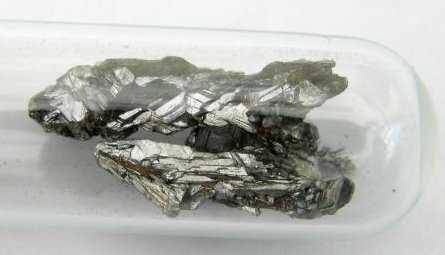Arsenic is a chemical element with the symbol As and atomic number 33. Arsenic occurs in many minerals, usually in combination with sulfur and metals, but also as a pure elemental crystal. Arsenic is a metalloid.
Symbol: As
Atomic number: 33
Electron configuration: [Ar] 3d¹⁰4s²4p³
Atomic mass: 74.9216 u
Discovered: 1250
Melting point: 816.8 °C
Discoverer: Albertus Magnus

List of facts
Arsenic is a chemical element with the symbol As
Arsenic has the atomic number 33.
The primary use of arsenic is in alloys of lead for example, in car batteries and ammunition.
The three most common arsenic allotropes are gray, yellow, and black arsenic, with gray being the most common
Arsenic and its compounds, especially trioxide, are used in the production of pesticides, treated wood products, herbicides, and insecticides
Arsenic is classified as a Group-A carcinogen
The United States Environmental Protection Agency states that all forms of arsenic are a serious risk to human health
Arsenic contamination of groundwater is a problem that affects millions of people across the world.
Arsenic occurs in nature as one stable isotope
Arsenic comprises about 1.5 ppm (0.00015%) of the Earth's crust
Arsenic is the 53rd most abundant element.
In 2014, China was the top producer of white arsenic with almost 70% world share, followed by Morocco, Russia, and Belgium
In the Renaissance era, arsenic was known as “inheritance powder” due to its use in killing family members.
The Greek word was adopted in Latin as arsenicum, which in French became arsenic, from which the English word arsenic is taken
The toxicity of arsenic to insects, bacteria, and fungi led to its use as a wood preservative
Arsenic was also used in various agricultural insecticides and poisons. For example, lead hydrogen arsenate was a common insecticide on fruit trees
In the second half of the 20th century, monosodium methyl arsenate (MSMA) and disodium methyl arsenate (DSMA) – less toxic organic forms of arsenic – replaced lead arsenate in agriculture.
Arsenic is used as a feed additive in poultry and swine production, in particular in the U.S. to increase weight gain, improve feed efficiency, and prevent disease
A 2006 study of the remains of the Australian racehorse, Phar Lap, determined that the 1932 death of the famous champion was caused by a massive overdose of arsenic
Lead components in car batteries are strengthened by the presence of a very small percentage of arsenic
Gallium arsenide is an important semiconductor material, used in integrated circuits
Circuits made from GaAs are much faster but also much more expensive than those made from silicon
Until recently, arsenic was used in optical glass. Modern glass manufacturers, under pressure from environmentalists, have ceased using both arsenic and lead.
In computers; arsenic is used in the chips as the n-type doping
Arsenic is absorbed by all plants but is more concentrated in leafy vegetables, rice, apple and grape juice, and seafood
During the Victorian era, arsenic was widely used in home decor, especially wallpapers
Naturally occurring sources of human exposure include volcanic ash, weathering of minerals and ores, and mineralized groundwater
Arsenic is also found in food, water, soil, and air
Arsenic was used during World War 1 – lewisite
Arsenic was also used during the Vietnam War – Agent Blue.
Arsenic properties
Arsenic in the periodic table |
|||||||||||||||
|---|---|---|---|---|---|---|---|---|---|---|---|---|---|---|---|
| Atomic number (Z) | 33 | ||||||||||||||
| Group | group 15 (pnictogens) | ||||||||||||||
| Period | period 4 | ||||||||||||||
| Block | p-block | ||||||||||||||
| Electron configuration | [Ar] 3d10 4s2 4p3 | ||||||||||||||
| Electrons per shell | 2, 8, 18, 5 | ||||||||||||||
Physical properties |
|||||||||||||||
| Phase at STP | solid | ||||||||||||||
| Sublimation point | 887 K (615 °C, 1137 °F) | ||||||||||||||
| Density (near r.t.) | 5.727 g/cm3 | ||||||||||||||
| when liquid (at m.p.) | 5.22 g/cm3 | ||||||||||||||
| Triple point | 1090 K, 3628 kPa[2] | ||||||||||||||
| Critical point | 1673 K, ? MPa | ||||||||||||||
| Heat of fusion | grey: 24.44 kJ/mol | ||||||||||||||
| Heat of vaporization | 34.76 kJ/mol (?) | ||||||||||||||
| Molar heat capacity | 24.64 J/(mol·K) | ||||||||||||||
Vapor pressure
|
|||||||||||||||
Atomic properties |
|||||||||||||||
| Oxidation states | −3, −2, −1, 0,[3] +1,[4] +2, +3, +4, +5 (a mildly acidic oxide) | ||||||||||||||
| Electronegativity | Pauling scale: 2.18 | ||||||||||||||
| Ionization energies |
|
||||||||||||||
| Atomic radius | empirical: 119 pm | ||||||||||||||
| Covalent radius | 119±4 pm | ||||||||||||||
| Van der Waals radius | 185 pm | ||||||||||||||
|
|
|||||||||||||||
Other properties |
|||||||||||||||
| Natural occurrence | primordial | ||||||||||||||
| Crystal structure | rhombohedral | ||||||||||||||
| Thermal expansion | 5.6 µm/(m⋅K)[5] (at r.t.) | ||||||||||||||
| Thermal conductivity | 50.2 W/(m⋅K) | ||||||||||||||
| Electrical resistivity | 333 nΩ⋅m (at 20 °C) | ||||||||||||||
| Magnetic ordering | diamagnetic[6] | ||||||||||||||
| Molar magnetic susceptibility | −5.5×10−6 cm3/mol[7] | ||||||||||||||
| Young's modulus | 8 GPa | ||||||||||||||
| Bulk modulus | 22 GPa | ||||||||||||||
| Mohs hardness | 3.5 | ||||||||||||||
| Brinell hardness | 1440 MPa | ||||||||||||||
| CAS Number | 7440-38-2 | ||||||||||||||
